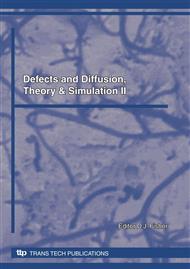[1]
P. Earhart and K. Able: Applied Physics Letters, 88 (2006) 201918.
Google Scholar
[2]
A.C.S. Sabioni, M.J.F. Ramos and W.B. Ferraz: Materials Research, 6.
Google Scholar
[2]
(2003) 173.
Google Scholar
[3]
M.A.D.N. Nogueira, W.B. Ferraz and A.C.S. Sabioni: Materials Research, 6.
Google Scholar
[2]
(2003) 167.
Google Scholar
[4]
G.W. Tomlins, J.L. Routbort and T.O. Mason: Journal of the American Ceramic Society, 81.
Google Scholar
[4]
(1998) 869.
Google Scholar
[5]
H. Haneda, I. Sakaguchi, A. Watanabe, T. Ishigaki and J. Tanaka: Journal of Electroceramics, 4[S1] (1999) 41.
Google Scholar
[6]
G.W. Tomlins, J.L. Routbort and T.O. Mason: Journal of Applied Physics, 87.
Google Scholar
[1]
(2000) 117.
Google Scholar
[7]
H. Haneda, I. Sakaguchi, A. Watanabe and J. Tanaka: Defect and Diffusion Forum, 143 (1997) (1919).
Google Scholar
[8]
E.A. Secco: Canadian Journal of Chemistry, 39 (1961) 1544.
Google Scholar
[9]
J. Liu, P. Gao, W. Mai, C. Lao, Z.L. Wang and R. Tummala: Applied Physics Letters, 89 (2006) 063125.
Google Scholar
[10]
B.N.N. Achar: Physical Review B, 10 (1970) 3848.
Google Scholar
[11]
Zaluska, L. Zaluski and J.O. Ström-Olsen: Applied Physics A, 72 (2001) 157.
Google Scholar
[12]
P. Keblinski, S.R. Phillpot, S.U.S. Choi and J. A. Eastman: International Journal of Heat and Mass Transfer, 45 (2002) 855.
Google Scholar
[13]
P. Plumulle and M. Vandevyver: Physica Status Solidi B, 73 (1976) 271.
Google Scholar
[14]
J. Serrano, F. Widulle, A.H. Romero, A. Rubio, R. Lauck and M. Cardona: Physica Status Solidi B, 235.
Google Scholar
[2]
(2003) 260.
Google Scholar
[15]
A.A. Maradudin, E.W. Montroll, G.H. Weiss et al.: Theory of Lattice Dynamics in the Harmonic Approximation, (2nd edition Academic Press, New York 1971).
Google Scholar
[16]
A.D. Leclaire: Philosophical Magazine, 14 (1966) 1271.
Google Scholar
[17]
N.L. Peterson and S.J. Rothman: Physical Review, 163.
Google Scholar
[3]
(1967) 645.
Google Scholar
[18]
W.J. Moore and E. L. Williams: Crystal Imperfections and the Chemical Reactivity of Solids (The Faraday Society, Aberdeen, Scotland, 1959), 86.
Google Scholar
[19]
R. Robin, A.R. Cooper and A.H. Heuer: Journal of Applied Physics, 44.
Google Scholar
[8]
(1973)3770.
Google Scholar
[20]
D. Hallwig and H.G. Sockel: Reactivity of Solids (Plenum, New York, 1977) p.631.
Google Scholar
[21]
K. Sadaiyandi and K. Ramachandran: Physica Status Solidi B, 170 (1992) K77.
Google Scholar
[22]
K. Sadaiyandi and K. Ramachandran: Physica Status Solidi B, 155 (1989) K85.
Google Scholar
[23]
Y. Madhavan, K. Ramachandran and T.M. Haridasan: Physica Status Solidi B, 158 (1990), 427.
Google Scholar
[24]
Y. Madhavan, K. Ramachandran and T.M. Haridasan: Physica Status Solidi B, 154 (1989) 55.
Google Scholar


